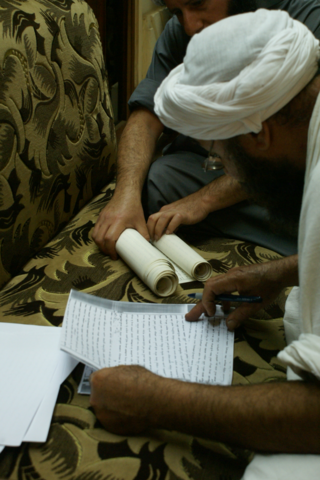Related Research Articles
Ethel, Lady Drower was a British cultural anthropologist, orientalist and novelist who studied the Middle East and its cultures. She was and is still considered one of the primary specialists on the Mandaeans, and was the dedicated collector of Mandaean manuscripts.
The Haran Gawaita also known as the Scroll of Great Revelation, is a Mandaean text which recounts the history of the Mandaeans as Nasoraeans from Jerusalem and their arrival in a region described as "Inner Harran which is called the mountains of Madday", which some scholars have identified with Media. The Haran Gawaita continues the historical narrative of the Mandaean Book of Kings, adding a new eighth age to the seven described in that work.
The Thousand and Twelve Questions is a Mandaean religious text. The 1012 Questions is one of the most detailed texts on Mandaean priestly rituals.
The Scroll of Exalted Kingship is a Mandaean religious text. Written as a large illustrated scroll, the text consists of 1363 lines. The scroll is a commentary on the initiation of the tarmida "junior priest".
The Baptism of Hibil Ziwa or Diwan Maṣbuta ḏ-Hibil Ziwa is a Mandaean illustrated scroll. It describes the soteriological descent of Hibil Ziwa to the World of Darkness, and his baptisms before and after. The scroll is essentially also a commentary on the masbuta, or Mandaean ritual baptism.

The Scroll of the Parwanaya is a Mandaean religious text that describes the rituals of the five-day Parwanaya festival. Excluding the colophon, the text consists of 931 lines.
The Wedding of the Great Shishlam is a Mandaean text. As a liturgical rather than esoteric text, it contains instructions and hymns for the Mandaean marriage ceremony. Traditionally, Mandaean priests recite the entire book at marriage ceremonies. The hymns in the text often contain the refrain "When the proven, the Pure One Went." Unlike most other Mandaean ritual scrolls, The Wedding of the Great Šišlam is not illustrated.

The Coronation of the Great Šišlam is a Mandaean religious text. The text is a detailed commentary on the initiation of the tarmida, with detailed discussions on masbuta and masiqta rituals. The Scroll of Exalted Kingship is also used extensively alongside the Coronation in tarmida initiation rituals. Similar esoteric texts that are traditionally used exclusively by Mandaean priests include The Thousand and Twelve Questions, and The Baptism of Hibil Ziwa.
Alma Rišaia Zuṭa is a Mandaean religious text. The text is used for Mandaean priestly initiation ceremonies. It is written as a scroll. Alma Rišaia Zuṭa complements Alma Rišaia Rba, or "The Greater Supreme World", a related Mandaic text used for priestly rituals.
Alma Rišaia Rba or Diwan Alma Rišaia Rabbā is a Mandaean religious text. The text is used for Mandaean priestly initiation ceremonies. It is written as a scroll and has numerous illustrations. Alma Rišaia Rba complements Alma Rišaia Zuṭa, or "The Smaller Supreme World", a related Mandaic text used for priestly rituals.
Yahya Bihram was a 19th-century Mandaean priest. Although initially a learned layman (yalufa), he became known for reviving the Mandaean priesthood after a cholera epidemic had killed all living Mandaean priests in 1831. He is mentioned in the colophons of various Mandaean manuscripts.
The Šarḥ ḏ-Zihrun Raza Kasia is a Mandaean religious text that describes rituals such as the masbuta, masiqta, and other related topics. It is an illustrated scroll.
Diwan ḏ-Qadaha Rba Šuma ḏ-Mara ḏ-Rabuta u-Dmut Kušṭa, or simply Dmut Kušṭa, is a Mandaean religious text. It is written as an illustrated scroll. No published translation of the text currently exists.
The Scroll of the Ancestors is a Mandaean religious text that describes the rituals of the Ṭabahata (ancestors') masiqta, held during the 5-day Parwanaya festival.
The Scroll of the Great Baptism is a Mandaean religious text. It is a ritual scroll describing the 360 baptisms (masbutas) for a polluted priest. The scroll is also called "Fifty Baptisms" and the Raza Rba ḏ-Zihrun.
In Mandaeism, a ʿniana or eniana prayer is recited during rituals such as the masiqta and priest initiation ceremonies. There is a total of 26 ʿniana prayers. They form part of the Qulasta.
Mandaean names can include both birth names and baptismal names, called malwasha (ࡌࡀࡋࡅࡀࡔࡀ) in Mandaic.
In Mandaeism, Yurba or Yorabba is an uthra. Lidzbarski spells his name as spelled Jōrabba. Yurba, who is also called the fighter, is identified with Shamish, the sun. In Mandaean texts, Yurba is often mentioned as engaging in conversation with Ruha. Gelbert (2013) also suggests that Yurba alludes to the historical Rabbula, a 5th-century bishop of Edessa.
Šafta ḏ-Pišra ḏ-Ainia is a Mandaean text used to protect against the evil eye.
References
- ↑ Buckley, Jorunn Jacobsen (2010). The great stem of souls: reconstructing Mandaean history. Piscataway, N.J: Gorgias Press. ISBN 978-1-59333-621-9.
- ↑ Morgenstern, Matthew (2013). New Manuscript Sources for the Study of Mandaic. In: V. Golinets et. al (eds.), Neue Beiträge zur Semitistik. Sechstes Treffen der Arbeitsgemeinschaft Semitistik in der Deutschen Morgenländischen Gesellschaft vom 09.–11. Februar 2013 in Heidelberg. AOAT, Ugarit Verlag.
- ↑ Müller-Kessler, Christa (2010). "A Mandaic Incantation Against an Anonymous Dew Causing Fright: Drower Collection 20 and Its Variant 43 E". ARAM (22). Peeters: 453–476. ISBN 9789042929579.
- ↑ Morgenstern, Matthew (ed.). "Qmaha ḏ-Gastata". The Comprehensive Aramaic Lexicon. Retrieved 2024-07-27.
- ↑ Bogdan Burtea, 'Ein mandäischer magischer Text aus der Drower Collection', in B. Burtea, J. Tropper, H. Younansardaroud, Studia Semitica et Semitohamitica. Festschrift Rainer Voigt zum sechzigsten Geburtstag, (Alter Orient und Altes Testament 317. Münster, 2005), pp. 93–123.
- ↑ Buckley, Jorunn Jacobsen (2002). The Mandaeans: ancient texts and modern people. New York: Oxford University Press. ISBN 0-19-515385-5. OCLC 65198443.
